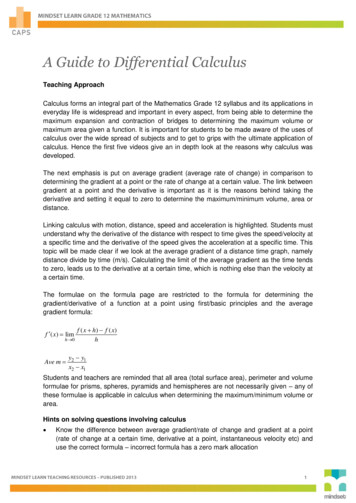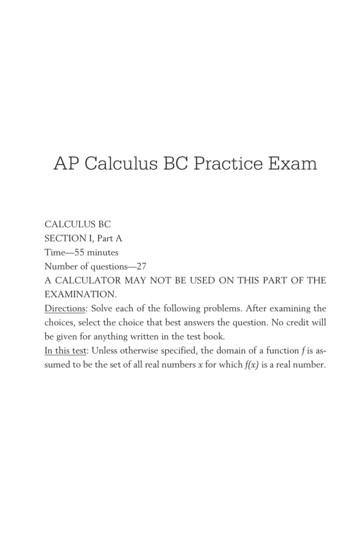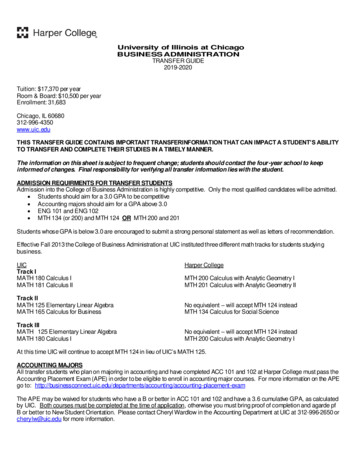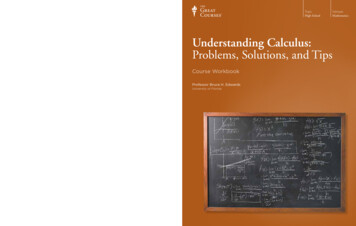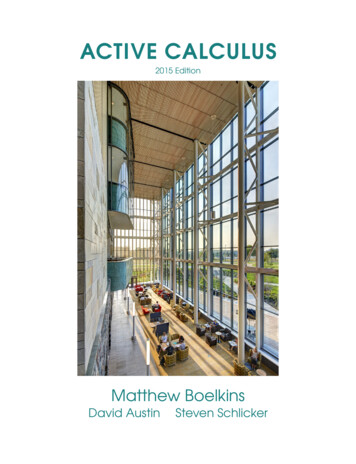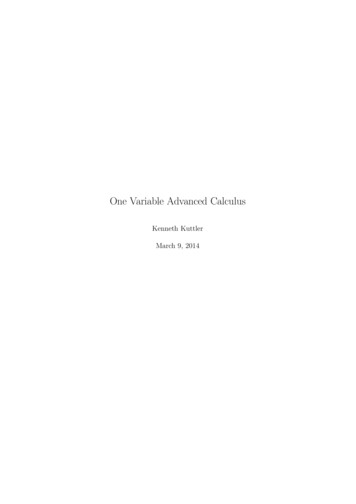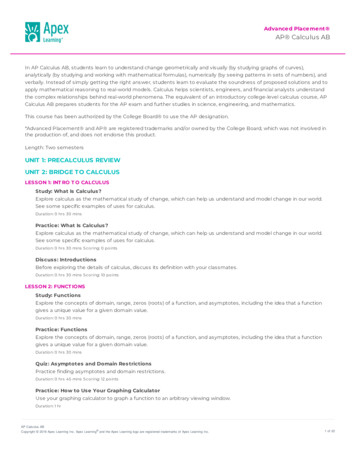
Transcription
ADVANCED CALCULUSLecture notes forMA 440/540 & 441/5412015/16Rudi WeikardlogHxL112345x-1-2Based on lecture notes by G. Stolz and G. WeinsteinVersion of September 3, 2016
1
ContentsFirst things first0.1. The goals0.2. The rules0.3. Hints0.4. The language of mathematics11123Chapter 1. The real numbers1.1. Field axioms1.2. Order axioms1.3. The induction principle1.4. Counting and infinity1.5. The least upper bound axiom55681011Chapter 2. Sequences and series2.1. Sequences2.2. Sums and the Σ-notation2.3. Series15151818Chapter 3.23A zoo of functionsChapter 4. Continuity4.1. Limits of functions4.2. Continuous functions4.3. The intermediate value theorem and some of its consequences4.4. Uniform convergence and continuity2727282929Chapter 5. Differentiation5.1. Derivatives5.2. The mean value theorem and Taylor’s theorem5.3. Uniform convergence and differentiation33333536Chapter 6. Integration6.1. Existence and uniqueness of integrals6.2. Properties of integrals6.3. The fundamental theorem of calculus6.4. Integration of piecewise continuous functions6.5. Uniform convergence and integration393941424243Chapter 7. Special topics7.1. Generalized limits7.2. Trigonometric functions and their inverses454546i
iiCONTENTS7.3.7.4.Analytic geometrySets of measure zero and some consequences4849Appendix A. Some set theory and logicA.1. Elements of logicA.2. Basics of set theoryA.3. FunctionsA.4. The recursion theorem5151525354Index55
First things first0.1. The goalsOur goal in this class is threefold:(1) to obtain a body of knowledge in Advanced Calculus, the basis of the analysis ofreal-valued functions of one real variable;(2) to learn how to communicate ideas and facts in both a written and an oral form;(3) and, perhaps most importantly, to become acquainted with — indeed, to master— the process of creating mathematics.In conducting this class we shall try to model a mathematical community in whichboth collaboration and competition are prevalent. This community is — no, you are —on the verge of discovering the foundations for a number of rules and recipes which havebeen successfully in use for some time. In the process you will recreate a body of knowledgealmost as if you were the first to discover it. However, as we have only nine months to dothis rather than a century or two, there will be some help available to you, most prominentlyin the form of these notes which will delineate broadly a path in which discovery will (orcould) proceed.In this course it is allowed and, in fact, required to criticize the person on the board forflaws or incomplete arguments (you are a scientific community). Criticism has to be leveledin a professional manner, in particular, it has to be free from any personal insults. At thesame time you have to learn to accept criticism without taking it personally. By learningto stand up for your ideas (or to accept that you made a mistake) you may get somethingout of this course which is of value not only in mathematics.0.2. The rulesThe following rules, based on intellectual and academic honesty, will be in force.(1) Everybody will have the opportunity to present proofs of theorems. You will havethe proof written out on paper and present it with the help of a document camera.(2) The audience (including the instructor) may challenge a statement made in thecourse of the proof at any point.(3) If the presenter is able to defend the challenged statement, he or she proceeds; ifnot, the presenter must sit down earning no points for this problem and losing theright to present again that day. The challenger may present his or her solution orelect to receive a challenge reward (see rules (10) and (12)).(4) A proof of a theorem will be considered correct if no one has objections (or furtherobjections). Its written version will then be “published” by uploading it to Canvas(it should have a title and the list of authors). The presenter and, if applicable,his or her collaborators (see rule (9)) will earn a total of 10 points at this time.1
2FIRST THINGS FIRST(5) During class the instructor has the final decision on determining whether an argument may stand or not. His verdict may still be challenged after a proof is“published” (see rule (6)).(6) If someone other than an author discovers a flaw in a “published” proof, he or shewill get the opportunity to explain the mistake and present a correct proof for atotal of 20 points.(7) While presenting proofs you may only refer to those axioms and theorems in thenotes which occur before the one you are working on, to published proofs of suchtheorems, to the definitions, and to the appendix.(8) You must give credit where credit is due, i.e., during your presentation you mustdeclare the points at which you had help and by whom.(9) It is also possible to report joint work. In such a case 4 points will be earned forthe presentation while the other 6 are evenly distributed among the collaborators.(10) The successor of a presenter will be chosen as the student with the smallest numberof points among the volunteers taking into account the modification by rules (3),(11) and (12). A die is rolled, if necessary.(11) You may volunteer for a particular problem by an e-mail to me. This (in the orderreceived) establishes priority among volunteers with the same number of points.(12) For a student who has earned a challenge reward 20 points will be subtracted fromhis or her current score for the purpose of determining a successor. At the timesuch a student is selected to prove a theorem the challenge reward expires.(13) Class attendance and participation is required. Absences from class are recordedin Canvas. After 10 absences from class 10 points will be subtracted from yourclass score and the count of absences is set again to zero.(14) There will be no partial credit except as described above to share credit.0.3. Hints As there is no partial credit, be well prepared to answer whatever questions mayarise. There is no need to take notes, final proofs will be “published”. Think alonginstead. Try to earn points early. The index at the end of these notes may lead you to some of the necessary definitions (let me know of any omissions). Often a proof will be fairly simple once one realizes that a previous result or aprevious method of proof can be used. Thus constant participation in class, evenwhen it’s other people’s turn to present, is highly advised! You should go over theproofs again at home and see if they are still clear to you, possibly rewriting themwith more details. Mathematical reasoning takes time. You may expect some frustration — withoutit there would never be a sense of accomplishment. Plan to spend a lot of timethinking about a problem before writing down a final solution. Exercises are for private study. Points are only earned for proofs of theorems. More difficult problems are marked with a . See me if you need help!
0.4. THE LANGUAGE OF MATHEMATICS30.4. The language of mathematicsMathematics is a highly formalized subject. In many ways learning it is similar to learning a foreign language. This language rests on two (tightly interwoven) pillars: logic and settheory. In this course we assume that you have a basic familiarity (possibly unconsciously)with both. Nevertheless Appendix A collects some fundamental material about set theorywhich you may (and will have to) use in your proofs. If you like you may also find someinformation in my algebra notes which are on my website1. There, at the ends of Sections1.2 and 1.3, are references to books on these subjects.Statements (true or false) are the bread and butter of mathematics. The more importantkind of statements are the following: Axioms: In a given mathematical theory some statements are taken for granted.Such statements are called axioms. The axioms, in fact, characterize the theory.Changing an axiom means to consider a different theory. Euclidean geometry, forinstance, relies on five axioms. One of them is the axiom of parallels. After tryingfor centuries to infer the parallel axiom from the other axioms mathematicians ofthe nineteenth century developed non-Euclidean geometries in which the parallelaxiom is replaced by something else. Definitions: A mathematical definition specifies the meaning of a word or phraseleaving no ambiguity. It may be considered an abbreviation. For instance, thestatement “A prime number is a natural number larger than one such that if itdivides a product of two natural numbers it divides one of the factors.” definesthe word prime number. Theorems: A theorem is a true statement of a mathematical theory requiringproof. It is usually of the form “p implies q”. For example the theorem “If n iseven, then n2 is divisible by 4.” is of this form. Sometimes, when a statementhinges only on the axioms, the theorem could simply be something like “2 is aprime number.”.Many authors also use the words proposition, lemma, and corollary. Logically these aretheorems and we will not use these words (but you should still look them up in a dictionaryif you ever want to talk to other people).1http://www.math.uab.edu/ rudi/teaching/algebra.pdf
CHAPTER 1The real numbersWe will introduce the real numbers R by a series of axioms, namely the field axioms, theorder axioms, and the least upper bound axiom. This means we will be sure of the preciseproperties of the real numbers. Of course, you probably already have some intuition as towhat real numbers are, and these axioms are not meant to substitute for that intuition.However, when writing your proofs, you should make sure that all your statements followfrom these axioms or their consequences proved previously. You will be amazed about therich world being created — by you — from these axioms.1.1. Field axiomsDefinition 1. A binary operation on a set A is a function from A A to A. It iscustomary to express a binary operation as a ? b (or with other symbols in place of ?). Anelement e A is called an identity if e ? a a ? e a for all a A. An element b A iscalled an inverse of a A if a ? b b ? a e, assuming e is an identity.Axiom 1 (Field axioms). For each pair x, y R, there is a unique element denotedx y R, called the sum of x and y, such that the following axioms of addition aresatisfied:(A1): (x y) z x (y z) for all x, y, z R (associative law of addition).(A2): x y y x for all x, y R (commutative law of addition).(A3): There exists an additive identity 0 R (in other words: x 0 x for allx R).(A4): Each x R has an additive inverse, i.e., an inverse with respect to addition.Furthermore, for each pair x, y R, there is a unique element denoted by x · y R (orsimply xy), called the product of x and y, such that the following axioms of multiplicationare satisfied:(M1): (xy)z x(yz) for all x, y, z R (associative law of multiplication).(M2): xy yx for all x, y R (commutative law of multiplication).(M3): There exists a multiplicative identity 1 R \ {0} (in other words: 1 · x xfor all x R).(M4): Each x R \ {0} has a multiplicative inverse, i.e., an inverse with respect tomultiplication.Finally, multiplication and addition satisfy the distributive law:(D): (x y)z xz yz for all x, y, z R.In formulating the distributive law we have made use of the convention to let multiplication take precedence over addition, i.e., x yz is short for x (yz).Any set which satisfies all the above axioms is called a field. Thus R, but also the setof rational numbers with which you are familiar, are fields.5
61. THE REAL NUMBERSExercise 1. Show that one may define binary operations in the set {0, 1} which turnit into a field. (This field is called Z2 .)Theorem 1. The additive identity in R is unique.Exercise 2. Is 0 an additive identity?Theorem 2. Every real number x has a unique additive inverse.The unique additive inverse of x R is called the negative of x and is denoted by x.For simplicity we will usually write x y in place of x ( y).Theorem 3. x y x z if and only if y z, assuming that x, y, z R.Theorem 4. Suppose x, y R. Then the following two statements hold.(1) If x y x then y 0.(2) If x y 0 then y x.Theorem 5. ( x) x for all x R.Theorem 6. There is a unique multiplicative identity in R and every non-zero realnumber x has a unique multiplicative inverse.The unique multiplicative inverse of x R \ {0} is called the reciprocal of x and isdenoted by x 1 . We will also use the notation x1 and 1/x in place of x 1 and we will usuallywrite xy or x/y for xy 1 .Theorem 7. If x, y, z R and x 6 0, then the following statements hold.(1) xy xz if and only if y z.(2) If xy x then y 1.(3) If xy 1 then y x 1 .(4) (x 1 ) 1 x.Theorem 8. For every x R we have 0x 0.Theorem 9. 0 does not have a reciprocal and neither is it the reciprocal of any number.Theorem 10. If x and y are non-zero real numbers, then xy 6 0.Theorem 11. Let x, y R. Then(1) ( 1)x x,(2) ( x)y (xy) x( y), and(3) ( x)( y) xy.Theorem 12. Let a, b R and x, y R \ {0}. Then a/x b/y (ay bx)/(xy).1.2. Order axiomsWe will now state the next set of axioms for the real numbers. We use the followingnotation: If A is a subset of R then A {x R : x A}.Exercise 3. Convince yourself that a A if and only if a A.Theorem 13. Suppose A is a subset of R. Then ( A) A.Axiom 2 (Order axioms). The set of real numbers R is an ordered field. This meansthat (in addition to being a field) R has the following property: There is a set P R suchthat
1.2. ORDER AXIOMS7(O1): P P ,(O2): P {0} P R, and(O3): If a, b P then a b P and ab P.We mention in passing that the rational numbers also form an ordered field.Theorem 14. 0 is neither in P nor in P.Exercise 4. Show that the field Z2 in Exercise 1 can not be ordered.Definition 2. The elements in P are called positive and those in P are called negative.The non-negative numbers are those in ( P)c P {0} while the non-positive numbers arethose in Pc P {0}.Definition 3. Let a and b be real numbers. We say that a b or, equivalently, b aif b a P. We say that a b or, equivalently, b a if b a P {0}.Theorem 15. 1 0.Theorem 16. Suppose a, b R. Then a b if and only if a b or a b.Theorem 17. Let x, y R. Then either x y or y x (or both).Theorem 18. Let x, y R. If x y and y x then x y.Theorem 19. For any two real numbers x and y exactly one of the following threestatements is true: x y, x y, or x y.Theorem 20. Let x, y, z R. If x y and y z, then x z.Theorem 21. Let x, y, z R. Then x y x z if and only if y z.Theorem 22. Let x, y, z R.(1) If 0 x and y z, then xy xz.(2) If x 0 and y z, then xz xy.Theorem 23. If x, y R and 0 x y, then 0 y 1 x 1 .These consequences of the order axioms show that one can represent the real numberson the familiar number line. The relationship x y is to be interpreted as “x lies to theleft of y”. It is often helpful to think along these lines when trying to devise proofs. Here2 1 1 and 3 2 1.-2-1 - 1201 13 2123Exercise 5. Identify the theorems which guarantee the ordering indicated in this sketchof the number line.Theorem 24. If x, y R and x y, then there exists a number z R such thatx z y.This shows that any field satisfying the order axioms will have many elements.Definition 4. Let a, b be real numbers. Each of the following types of subsets of Ris called a finite interval : (a, b) {x R : a x b}, [a, b) {x R : a x b},(a, b] {x R : a x b}, and [a, b] {x R : a x b}. The following sets
81. THE REAL NUMBERSare called infinite intervals: ( , a) {x R : x a}, ( , a] {x R : x a},(a, ) {x R : a x}, [a, ) {x R : a x}, and ( , ) R. The intervals(a, b), ( , a), and (a, ) are called open intervals while [a, b], ( , a], and [a, ) arecalled closed intervals. The interval ( , ) is considered both an open and a closedinterval.Note that the empty set is also considered to be an interval, in fact both an open anda closed interval since (a, b) [a, b] if a b.1.3. The induction principleDefinition 5. A subset S of R is called inductive, if 1 S and if x 1 S wheneverx S.Theorem 25. The sets R, P, and [1, ) are all inductive.Definition 6. The intersection of all inductive sets is called the set of natural numbersand is denoted by N. The set Z N {0} N is called the set of integers or whole numbers.The set Q {m/n : m Z, n N} is called the set of rational numbers.Exercise 6. If the sets A and B are inductive, then so is A B.Theorem 26. N is inductive. In particular, 1 is a natural number.Theorem 27. If n is a natural number, then n 1.Theorem 28 (The induction principle). If M N is inductive, then M N.The induction principle gives rise to an important method of proof, the so called induction proofs of which we will see many: M N, if M has the three properties (i) M N,(ii) 1 M , and (iii) n M : n 1 M .Definition 7. If n N we call n 1 the successor of n and n the predecessor of n 1.Theorem 29. 1 is the only natural number without a predecessor.Theorem 30. (n, n 1) N whenever n N.Induction may also be used to define concepts. We give some important examples (notethat these depend on the recursion theorem, see Appendix A).Definition 8. Let n be a naturalPn number and g a function from N to R. The sum ofthe first n terms of g, denoted by k 1 g(k), is defined inductively by1Xg(k) g(1) andk 1n 1Xg(k) g(n 1) k 1k 1g(k) g(1) andn 1Yg(k).k 1Also, the product of the first n terms of g, denoted by1YnXQnk 1g(k), is defined inductively byg(k) g(n 1)k 1nYg(k).k 1Definition 9 (Factorial). For natural numbers n one defines the number n! (pronounced ‘n factorial’) bynYn! k.k 1In particular, 1! 1, 2! 2, and 3! 2 · 3 6. One also defines 0! 1 (get used to it).
1.3. THE INDUCTION PRINCIPLE9QnDefinition 10 (Powers). If x R and n N, then the number k 1 x is called then-th power of x. It is denoted by xn . We also define x0 1 and, for x 6 0, x n (x 1 )n .In particular 00 1 (get used to that, too).Theorem 31. For any n NnXcak ck 1nXakk 1when c and the ak are real numbers.Theorem 32. For any n N and real numbers ak and bknX(ak bk ) k 1nXk 1ak nXbk .k 1Theorem 33. If the ak are real numbers and n N, thenan a0 nX(ak ak 1 ).k 1A sum like the one on the right of the previous equation is called a telescoping sum.Theorem 34. If m and n are natural numbers, then so are n m and nm.Theorem 35. The sum of the first n natural numbers is n(n 1)/2, i.e.,nXk k 11n(n 1)2for all n N.Theorem 36. Let a be real number different from 1 and n a natural number. ThennX1 an 1ak a0 .1 ak 1Theorem 37 (Bernoulli’s1 inequality). If a 1 and n N, then (1 a)n 1 na.Theorem 38. For all n N it is true thatnXn(n 1)(2n 1)k2 .6k 1Theorem 39. If a 6 0 and m, n Z, then am an am n and (am )n amn . Moreover,if a, n N, then an N.Next, we present the well ordering principle. It is actually equivalent to the inductionprinciple and sometimes comes handy in proofs.Theorem 40 (The well-ordering principle).* Let S N and S 6 . Then S contains asmallest element (denoted by min S).Theorem 41. Suppose 0 q Q. Then there exist m, n N such that m/n q and,if k/ q for k, N, then m k and n .1Jacob Bernoulli (1654 – 1705)
101. THE REAL NUMBERSIn the situation of the previous theorem m/n is called the representation of q in lowestterms. A negative rational number q also has a representation in lowest terms, namely m/n, if m/n is the representation in lowest terms of q 0.Theorem 42. There is no rational number r for which r2 2.Is there are real number whose square is 2? It will turn out that introducing the realnumbers allows to handle this deficiency. In fact, that’s why real numbers were invented.1.4. Counting and infinityThis section deals with counting and the notion of infinity. For a given n N letZn {k N : k n}.Definition 11. A set X is called finite if it is empty or if there exists an n N and asurjective function ϕ : Zn X. Otherwise the set is called infinite.If X is a non-empty finite set, then min{k N : surjective function ϕ : Zk X} iscalled the number of elements2 in X and is denoted by #X.Exercise 7. Find out what Z1 , Z2 , and Z3 actually are. Then find all functionsϕ : Z1 Z1 and all functions ψ : Z2 Z2 . Which of these are injective and which aresurjective? Also, find all injective functions τ : Z3 Z3 .Exercise 8. Think about how counting is related to surjections, injections, and bijections.Theorem 43. #Zn n.Theorem 44. #Zn n.Theorem 45. Suppose X is a non-empty finite set. If there is a bijective function fromX to Zn , then #X n. Conversely, if #X n and ϕ : Zn X is surjective, then it is, infact, bijective.Theorem 46. N is infinite.Theorem 47. Suppose X and Y are sets and X Y . Then the following two statements are true:(1) If X is infinite, then Y is infinite.(2) If Y is finite, then X is finite.Definition 12. A set X is called countable if it is empty or if there exists a surjectivefunction φ : N X. Otherwise it is called uncountable. A set which is countable but notfinite is called countably infinite.Theorem 48. Every finite set is countable and N is countably infinite.Theorem 49.* Z, N N, and Q are countably infinite.2This number exists by Theorem 40.
1.5. THE LEAST UPPER BOUND AXIOM111.5. The least upper bound axiomNote that the set of rational numbers, just like the set of real numbers, is an ordered field(identify the set P which shows this). So far, for all we know, these sets could be identical.Only the least upper bound axiom, which is our final axiom, distinguishes between the two.Definition 13. Let S be a subset of R. The number b is called an upper bound of S ifx b for all x S. It is called a lower bound of S if x b for all x S. If S has an upper(or lower) bound it is called bounded above (or bounded below). S is called bounded if it hasboth an upper and a lower bound.Exercise 9. Every element of P is an upper bound of P. What is the least upperbound of P?Definition 14. Let S be a subset of R, which is bounded above, and U the set of allits upper bounds. A number c is called a least upper bound of S or a supremum of S if itis an upper bound of S and a lower bound of U . Similarly, if S is bounded below and L isthe set of all lower bounds of S, then a number c which is a lower bound of S and an upperbound of L is called a greatest lower bound of S or an infimum of S.Theorem 50. Suppose a, b R and a b. Then b is a least upper bound and a is agreatest lower bound of (a, b).Theorem 51. If a least upper or a greatest lower bound of S exists, then it is unique.We are now ready to state our final axiom of the real numbers. This means thatall desired results on the real numbers have to be proven by using nothing more thanAxioms 1 — 3 (and results which are known to follow from these axioms).Axiom 3 (Least Upper Bound Axiom). Any non-empty subset of R which is boundedabove has a least upper bound.Both Q and R satisfy Axioms 1 and 2 (they are both ordered fields). It is Axiom 3which makes all the difference (a tremendous difference as we will see) between the rationaland the real numbers.Theorem 52. Let S be a subset of R. The set S is bounded above if and only if S isbounded below and the number b is an upper bound of S if and only if b is a lower boundof S.Theorem 53. If S is a non-empty subset of R which is bounded below, then S has agreatest lower bound.Definition 15. If S is a subset of R which has a least upper bound we will denote thisuniquely defined number by sup S. If sup S is an element of S, it is called a maximum of Sand is denoted by max S. Similarly, the greatest lower bound of a set S (when it exists) isdenoted by inf S. If inf S is an element of S, it is called a minimum of S and is denoted bymin S.Theorem 54. If either of the numbers sup S and inf( S) exist, then so does the other.Moreover, in this case, sup S inf( S).Theorem 55. Let S be a bounded non-empty subset of R. Then inf S sup S.Theorem 56. Suppose that 6 T S R.(1) If S is bounded above, then T is bounded above and sup T sup S.
121. THE REAL NUMBERS(2) If S is bounded below, then T is bounded below and inf T inf S.Theorem 57 (Archimedian3 property). Let a, b R and a 0. Then there exists anatural number n such that na b.The following innocent looking theorem will be very important later on when we willlook at limits.Theorem 58. Let x be a real number such that 0 x 1/n for every natural numbern. Then x 0.Theorem 59. If x and y are real numbers and x y, then there exists q Q such thatx q y.Because of this last theorem one says that the rational numbers are dense in R butrecall from Theorem 42 that despite of this there are still holes on the number line. This iswhy the real numbers are sorely needed.Our next goal is to prove the existence of square roots of positive real numbers. Wewill then use this to show that the rational numbers do not satisfy the least upper boundaxiom.Theorem 60. Suppose x, y 0 are real numbers. Then x y if and only if x2 y 2 .Theorem 61. Let y 0 be a real number and E {z R : z 0, z 2 y}. Then E isnot empty and bounded above.Theorem 62.* Let y 0 be a real number. Then there exists a real number x 0 suchthat x2 y.Definition 16. Let x and y be real numbers. x is called a square root of y if x2 y.Theorem 63. A real number y 0 has no square root. The number y 0 has exactlyone square root, namely 0. A real number y 0 has exactly two square roots; these arenegatives of each other. Definition17. If x 0, then we denote by x the unique positive square root of x. Also 0 0.We will usually call this number the square root of y 0, even if we actually should bemore precise and call it the non-negative square root. Theorem 64. If a 0 and b 0, then ab a b.Theorem 65. The rational numbers Q do not satisfy the Least Upper Bound Axiom.More precisely, if A Q is bounded above and U is the set of all rational upper bounds ofA, then U may not have a least element.As the final subject of this chapter we will discuss absolute values.Definition 18. The absolute value of x R is defined by(xif x 0, x x if x 0. Theorem 66. Let x, y be any real numbers. Then x2 x and xy x y .3Archimedes of Syracuse (ca. 287 BC – 212 BC)
1.5. THE LEAST UPPER BOUND AXIOM13Theorem 67. Suppose a and x are real numbers and c is a positive real number. Then x x x . Moreover, the interval (a c, a c) equals the set {x R : x a c}.Theorem 68 (Triangle inequality). If x, y R, then x y x y and x y x y .Definition 19. Let X be a set. A function d : X X [0, ) is called a metric ordistance function if it has the following properties:(1) d(x, y) 0 if and only if x y.(2) d(x, y) d(y, x) for all x, y X.(3) d(x, y) d(x, z) d(z, y) for all x, y, z X.(X, d) is then called a metric space. The number d(x, y) is called the distance between xand y.Property (3) is also called triangle inequality.Theorem 69. The function R R [0, ) : (x, y) 7 x y is a metric.Note that, by Theorem 67, the interval (a c, a c) is the set of all real numbers whosedistance from a is less than c.
CHAPTER 2Sequences and series2.1. SequencesDefinition 20. A sequence of real numbers is a function which maps N to R.For a sequence x : N R we will usually write n 7 xn , where xn is traditionally usedfor the value x(n) of the function x at n.Exercise 10. For the sequence x : n 7 1/n and y : n 7 1/n2 consider where thepoints xn and yn fall on the number line.We have the impression that these sequences approach (whatever that might mean)zero. How could we make such a notion precise?Exercise 11. Show that 1/n 0 1/100 for all n 100 and 1/n 0 1/1000 forall n 1000.Exercise 12. Intuitively, what number L do the entries of the sequence n 7 xn (n2 ( 1)n )/n2 approach?Exercise 13. Consider the sequence from the previous exercise and suppose ε 1/100.Find an N R such that xn L ε for all n N . What about ε 1/500? What willhappen for even smaller ε? Note that ε describes the error we allow.Definition 21. Let x : n 7 xn be a sequence. We say that x converges to the realnumber L if for every positive real number ε there is an N R such that xn L εwhenever n N ; or, more concisely, ε 0 : N R : n N : xn L ε.We say that the sequence x converges or is convergent if there is a real number L suchthat x converges to L. If a sequence is not convergent, we say that it diverges or is divergent.Theorem 70. If c R, then x : n 7 xn c converges to c.Theorem 71. The sequence n 7 1/n converges to 0.Theorem 72. If the sequence x converges to L1 and also to L2 , then L1 L2 .Definition 22. If a sequence x converges to L, then L is called the limit of x and wewritelim xn L.n Definition 23. We say that a sequence is bounded above (or below) if its range isbounded above (or below). A sequence is called bounded if it is bounded both above andbelow.Theorem 73. A finite set of real numbers is bounded.15
162. SEQUENCES AND SERIESTheorem 74. If a sequence converges, then it is bounded.Theorem 75. The sequence n 7 n diverges.Theorem 76. The sequence n 7 ( 1)n diverges.Theorem 77. If limn xn L, then limn xn L .Theorem 78. If limn xn L and limn yn M , then limn (xn yn ) L M .Theorem 79. If c R and limn xn L, then limn cxn cL.Theorem 80. If limn xn L and limn yn M , then limn xn yn LM .Theorem 81. If limn xn 0 and the sequence y is bounded, then limn xn yn 0.Theorem 82. If xn 6 0 for all n N and if limn xn L 6 0, then limn 1/xn 1/L.Theorem 83. For eve
ADVANCED CALCULUS Lecture notes for MA 440/540 & 441/541 2015/16 Rudi Weikard 1 2 3 4 5 x - 2 - 1 1 l

